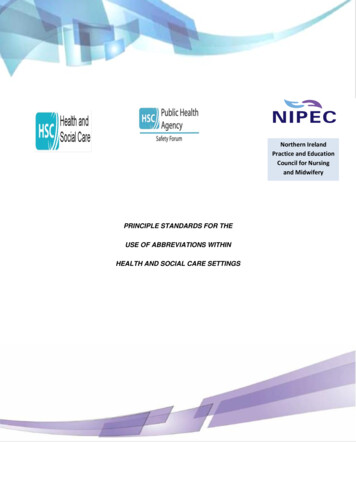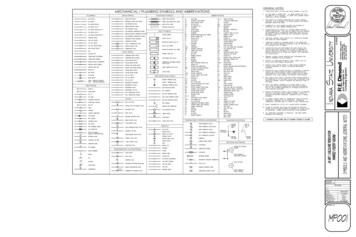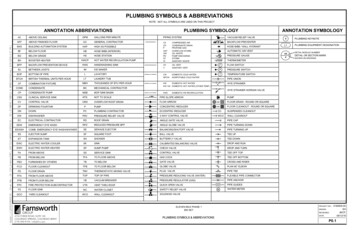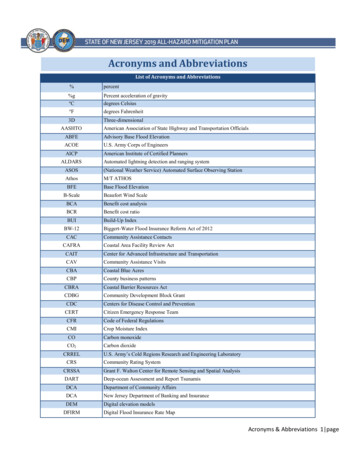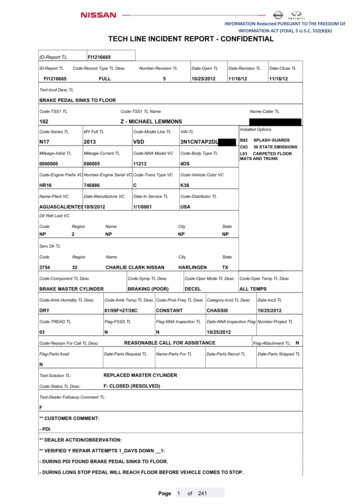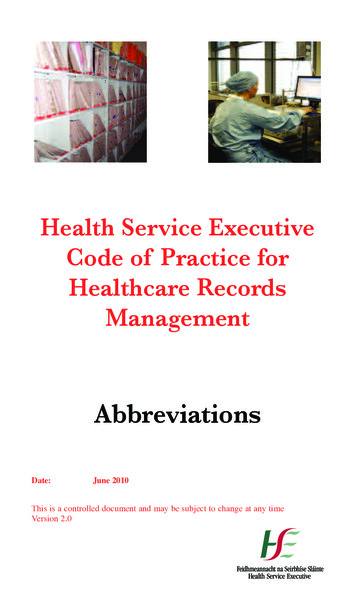
Transcription
Health Service ExecutiveCode of Practice forHealthcare RecordsManagementAbbreviationsDate:June 2010This is a controlled document and may be subject to change at any timeVersion 2.0
ReaDeR InfoRmatIonDirectorate:Quality & Clinical Care Directoratetitle:HSE Code of Practice for HealthcareRecords ManagementDocumentPurpose:AbbreviationsPublication Date:June 2010target audience:All staff in the HSE who work inhealthcare records managementDescription:This section is intended to encourage bestpractice while assisting healthcareprofessionals to make effective use oftheir time, by providing a list of agreedabbreviations, which are approved for usethroughout the HSESuperseded Docs: Version 1 June 2007Review Date:June 2012Contact Details:Winifred Ryan,Quality & Clinical Care Directorate,Health Service Executive.Email: urphy@hse.ieWeb: www.hse.ie-2-
table of ContentsPage1.Rules for abbreviations42.Drugs and Prescribing72.1Doses82.2Frequency of Administration92.3Days of the Week102.4Time Abbreviations112.5Routes of Administration112.6Prescribing electrolytes andtrace elements122.7Interpretation of dose frequencyinstructions133.4.approved abbreviations Listfor Use in Healthcare Records15notation for mobilisationsand manipulations53-3-
1. Rules for abbreviations1.1Abbreviations should be avoided if at all possible, but inthe event of abbreviations being utilised, only thoseapproved by the Quality & Clinical Care Directorate andcontained within this document are permitted.1.2If an abbreviation is used that is not contained within thisdocument the full term used, followed by the abbreviationin brackets, should be written on each side of each page.1.3All abbreviations must be written in Block Capitals (e.g.MI – Myocardial infarction). Contractions can beexpressed as a mixture of higher and lower case.Contractions used in this document omit the end of a wordand are terminated with a full stop (e.g., Ausc. –Auscultation).1.4The following must neVeR be abbreviated.never abbreviate decisionsregarding resuscitation ofa patientAny decision regardingresuscitation of a patient mustalways be written in full andsigned. A decision of suchgravity must never beabbreviated.never abbreviate drugnamesDrug names must always bewritten in full and shall neverbe abbreviated under anycircumstances.never use R and LRight and left must be writtenin full. The exception to thisrule is when right or left iscontained within anabbreviation, e.g. LIF – leftiliac fossa.-4-
, less than and greater than should beavoided except where theyare part of an officialgrading system(i.e. urinalysis results)Accepted grading systemsshould only be usednever use these symbols ve and –ve ve and –ve are not acceptable.These can be abbreviated toPos. and Neg.any reference to the service The service user/patient’s givenuser/patient must never be name should always be used.abbreviatedabbreviations must neverbe used on a consent formabbreviations must neverbe used in the completionof incident report forms1.5Laboratory tests may be abbreviated on typed reports butonly approved abbreviations contained within thisdocument may be hand-written in service user/patienthealthcare records. If an abbreviation is used that is notcontained within this document the full term used,followed by the abbreviation in brackets, should bewritten on each side of each page.1.6Abbreviations pre-printed or typed on Health ServiceExecutive documentation (and on computer) can remainunchanged, as they are generally understood. Anexplanatory footnote added to the document, prior toreprinting, in order to clarify the meaning of typedabbreviations is necessary.1.7To deliver best practice it is essential that all of theabbreviation rules and recommendations apply toelectronic clinical information also. With the move withinthe healthcare service to the development and delivery ofintegrated Electronic Patient Records, healthcare providers-5-
must endeavour to produce systems, which will containand produce no abbreviations. In the interim:1.7.1 Current systems can remain unchanged as they arealready approved and agreed locally.1.7.2 When current systems are upgraded or changedabbreviations must be omitted.1.7.3 Information printed or shared from current systemsmust:llContain no abbreviationsIf they contain abbreviations a footnote mustbe added that clarifies the meaning of theabbreviations.1.8References to referrals or discussions with other healthprofessionals (e.g. doctors, nurses, health and social careprofessionals) must state their full name; title and bleepnumber if applicable (e.g. seen by ‘Physio or SurgicalIOC’ is not a substitute for their name).1.9International chemical symbols are acceptable in clinicaldocumentation e.g. Fe Al except in prescriptions and/ormedication charts.1.10 In designating time in clinical documentation the 24 hourclock must be used.1.11 No abbreviations to be used in documentation orcorrespondence which is used for transfer, discharge orexternal referral letters.1.12 This document is intended to reduce error and confusionby providing the generally accepted or preferredabbreviations and acronyms that have been approved bythe Quality & Clinical Care Directorate.-6-
2. DRUgS anD PReSCRIbIngalways write clearly when prescribing, using un-joinedlower case text, or bLoCK CaPItaLS.Where possible prescribe medications, including intravenousfluids, using approved generic name, where this is not possiblethe drug name used must be on the local approved list of tradename drugs except in the case of multi-ingredient preparationsand modified release formulations when the brand names mustbe used.note: Always document patient drug allergies or idiosyncraticreactions and refer to documented allergies and reactions beforeprescribing any drug.Drug names must never be abbreviated under anycircumstancestable 1 Checklist when PrescribingYOuR HANDWRITINg MuST BE CLeaR & LegIbLeuSINg uN-JOINED LOWER CASE TExT OR BLOCk CAPITALSAllergiesAlways check and documentDrug NamesNever abbreviate drug namesPrescribinguse approved (generic) nameswhere possible. Where this isnot possible the drug name usedmust be on the local approvedlist of trade name drugs.-7-
2.1DoSeS2.1.1 UnitsThe following units may be abbreviated only as follows:table 2 Unitsapproved imetreMillimolenever abbreviate the following: International units,Micrograms, Nanograms, unitse.g. Insulin Actrapid 8 units, Tinzaparin 10,000 InternationalunitsNever use the unit cubic centimetre, or the abbreviations c.c. orcm3 to denote millilitres, e.g. Vancomycin1g/100ml, Fluconazolesuspension 200mg/5ml2.1.2 Decimal PointslllQuantities less than 1 gram should be written inmilligrams, e.g. 500mg, not 0.5g.When decimals are unavoidable a zero should bewritten in front of the decimal point where there isno other figure, e.g. 0.5mL. not .5mLThe use of the decimal point is only otherwiseacceptable to express a range, e.g. 0.5 to 1g-8-
2.2fReqUenCy of aDmInIStRatIonAlways specify the dose and frequency.lIn the case of preparations to be taken “as required”, alwaysspecify the minimum dose interval e.g. Paracetamol tablets500mg 2 every 6 hours p.r.n.Directions must generally be in english withoutabbreviations (exceptions listed in Table 2.3)table 3acceptable Latin terms and abbreviationsLatin terms andabbreviationsenglish meaningb.d./b.i.d.Twice dailyManeIn the morningNocteAt nightp.r.n.When requiredq.d.s./q.i.d.Four times dailySTATImmediatelyTardeIn the eveningt.d.s./t.i.d.Three times dailyIn the case of drugs that are being prescribed at particular hourlyfrequencies, the only acceptable way of writing these are:l12 hourly or twelve hourly or every 12 hours orevery twelve hoursl4 hourly or four hourly or every 4 hours or everyfour hoursNo other method of expressing this dosage is acceptableincluding q12h, 120, q4h, q.q.h., 40no other abbreviation or Latin term may be used-9-
The left hand column of Table 2.4 contains abbreviations thatshould not be used. The correct term is given in the right handcolumn.table 4Unacceptable abbreviationAlt Dieo.d.q.d.q.q.hq.4.hq.6.hq.12.hm.d.uAd lib2.3Correct term (always writein full)On alternate daysOnce dailyOnce dailyEvery four hoursEvery four hoursEvery six hoursEvery twelve hoursAs directedAs much as desiredDayS of tHe WeeKDays of the week must not be abbreviated but must always bewritten in full. For drugs to be administered only on specificdays of the week then those days must always be written in full.example 1A Prescription for once weeklyMethotrexate must state the drug name,dose and specific weekly day for drugadministration, with no abbreviationsother than the route, e.g. Methotrexate2.5mg P.O. once weekly on Wednesdays.example 2A prescription for thrice weeklyErythropoietin Beta must state the drugname, dose and the three specific days perweek for drug administration, with noabbreviations other than the route, e.g.Erythropoietin Beta 2,000 units I.V. threetimes weekly on Monday, Wednesday andFriday.- 10 -
2.4tIme abbReVIatIonSThe following abbreviations are applicable with regard to timeand rates of administration of medicines:table eS of aDmInIStRatIonThe following abbreviations may be used for routes ofadministration:table NgNasogastricPEgPercutaneous EndoscopicgastrostomyPOPer Oral (i.e. oral by mouth)PVPer VaginalSCSubcutaneouslyPRPer RectumSLSublinguallyabbreviations may not be used for other routes. Insteadwrite the term in full, e.g. intradermally, intrathecally,intraperitoneally, transdermally.- 11 -
2.6PReSCRIbIng eLeCtRoLyteS & tRaCe eLementSonLy the following abbreviations for electrolytes areacceptable in prescriptions.table 7approved abbreviationCa2 electrolyteMg2 Na MagnesiumSodiumk PotassiumCL-ChlorideCalciumThe following terms must never be abbreviated inprescriptions:l Acetatel Aluminiuml Bicarbonatel Chromiuml Copperl Ferricl Ferrousl Fluoridel Iodidel Ironl Lactatel Manganesel Molybdenuml Phosphatel Seleniuml Sulphatel Zinc- 12 -
2.7InteRPRetatIon of DoSe fReqUenCy InStRUCtIonSAs the timing of drug administration rounds differs frominstitution to institution no specific guidance is providedregarding a unified policy on Standard Times for DrugAdministration. Each hospital is, however, strongly encouragedto have a specific local policy on Standard Times for DrugAdministration.table 8abbreviationmeaningq.d.s./q.i.d.Four times daily, this ideallymeans every six hours. It isgenerally impractical toadminister any medicine atstrictly six hourly intervals, asthe service user/patient wouldhave to be awakened.t.d.s./t.i.d.Three times daily, this ideallymeans every eight hours.b.d./b.i.d.Twice daily, this ideally meansevery twelve hours. For drugsthat are prescribed twice dailyand are not intended foradministration at twelve hourlyintervals, the specificinstructions must be included onthe prescription i.e. Diuretics 1b.d. The dose must read, asappropriate, 1 in the morningand 1 at lunchtime etc.- 13 -
abbreviationmeaningonce DailyThis means every 24 hours.For drugs that are intended foradministration at a specifictime the prescription mustreflect this fact and not beprescribed simply as once dailyi.e. diuretics in the morning,hypnotics at night. Care mustbe taken when a drug isprescribed once daily that theservice user/patient will takethe drug at the same time eachday or else complianceproblems can arise.Drugs and meal timesDietary considerations must betaken into account when drugsare being prescribed/administered. If drugs are besttaken on an empty stomachthey must be given at least 30minutes before the nextmealtime. If drugs are besttaken with or after meals thenthey must be given at mealtimes. It is generally moreimportant that the dietaryconsiderations take precedenceover strict adherence to theoptimum time ofadministration.- 14 -
3. aPPRoVeD abbReVIatIonS LISt foRUSe In HeaLtHCaRe , diplopia, dropattacks, dysorthria, dysphagiaNine hole peg nAids and AppliancesAbdominal aortic aneurysmAcute angle closure glaucomaAssisted active range ofmovement/motionApnoea/BradycardiaAirway breathing circulationAbdominalArterial blood gasAnkle brachial indexBlood group systemAllergic broncho pulmonaryaspergillosisAnkle brachial pulse indexAbsorbableActive cycle of breathingtechniqueAfter coming headAcromioclavicular jointAnterior cruciate ligamentAcute coronary syndromeAirway clearance techniqueAlzheimer’s DiseaseAdductionAcute disseminatedencephalomyelitis- 15 -
. Fib.A. . ntidiuretic hormoneAttention deficit hyperactivitydisorderActivities of daily livingAdmission/admittedAssistant Director ofMidwifery/NursingAssistant Director of PublicHealth NursingAir entryAbsent end diastolic flowAtrial ectopic tachycardiaArtificial feedAtrial fibrillationAtrial flutterAnkle foot orthosisAverage flow rateAmniotic fluid volumeAbdominal girthAppropriate gestational ageAortic incompetenceAcquired immune deficiencysyndromeAnterior inferior iliac spineAbove kneeAbove knee amputationAcute kidney injuryAlbuminAnterior lumbar intervertebralfusionAlkaline PhosphataseAcute lymphoblastic leukaemiaAnterior levator resectionAlanine amino transferaseMorning before twelveAcute myocardial infarctionAcute myeloid leukaemiaAdvanced Midwife PractitionerAntinuclear AntibodyAdverse neural dynamicsAnaesthetic- 16 -
abbreviationANPAnt.Anti-DVTAnt. Lat.Ant. Tibs.Ao.Ao. archAo. rootAo. ARFARMARMDAROMASA
Abbreviations D-@1: JA:1 2010 This is a controlled document and may be subject to change at any time Version 2.0 - 2 - &eaDe& Info&ma . 1.9 International chemical symbols are acceptable in clinical documentation e.g. Fe Al except in prescriptions and/or medication charts. 1.10 In designating time in clinical documentation the 24 hour clock must be used. 1.11 No abbreviations to be used in .
